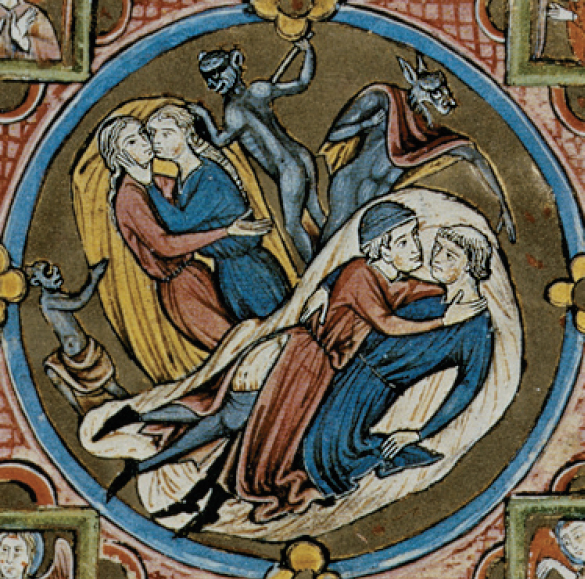Sex in the City
Peasant and urban revolts and riots had clear economic bases, but some historians have suggested that late medieval marital patterns may have also played a role. In northwestern Europe, people believed that couples should be economically independent before they married. Thus, men and women spent long periods as servants or workers in other households, saving money for married life and learning skills, or they waited until their own parents had died and the family property was distributed.
Men of all social groups had long tended to be older than women when they married. In general, men were in their middle or late twenties at first marriage, with wealthier urban merchants often much older. Journeymen and apprentices were often explicitly prohibited from marrying, as were the students at universities.
The prohibitions on marriage for certain groups of men and the late age of marriage for most men meant that cities and villages were filled with large numbers of young adult men with no family responsibilities who often formed the core of riots and unrest. Not surprisingly, this situation also contributed to a steady market for sexual services outside of marriage, services that in later centuries were termed prostitution. In many cities, municipal authorities set up houses or districts for prostitution either outside the city walls or away from respectable neighborhoods.
Young men associated visiting brothels with achieving manhood; for the women themselves, of course, their activities were work. Some women had no choice because they had been traded to the brothel manager by their parents or some other person as payment for debt, or they had quickly become indebted to the manager (most of whom were men) for the clothes and other finery regarded as essential to their occupation. Poor women — and men — also sold sex illegally outside of city brothels, combining this with other sorts of part-
Though selling sex for money was legal in the Middle Ages, the position of women who did so was always marginal. In the late fifteenth century, cities began to limit brothel residents’ freedom of movement and choice of clothing, requiring them to wear distinctive head coverings or bands on their clothing. Cities also began to impose harsher penalties on women who did not live in the designated house or section of town. A few women who sold sex did earn enough to donate money to charity or buy property, but most were very poor.
Along with buying sex, young men also took it by force. Unmarried women often found it difficult to avoid sexual contact. Many worked as domestic servants, where their employers or employers’ sons or male relatives could easily coerce them, or they worked in proximity to men. Notions of female honor kept upper-
Same-

How prevalent were same-
Thus, in Florence, and no doubt elsewhere in Europe, sodomy was not a marginal practice, which may account for the fact that, despite harsh laws and special courts, actual executions for sodomy were rare. Same-